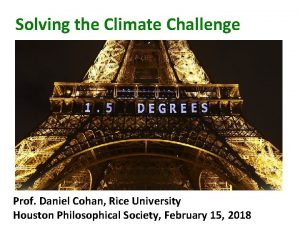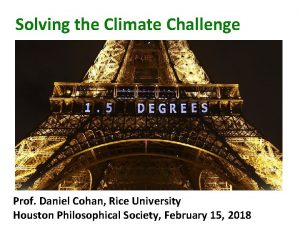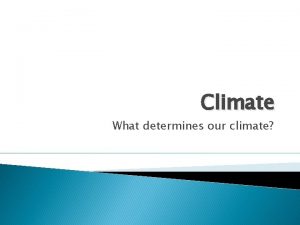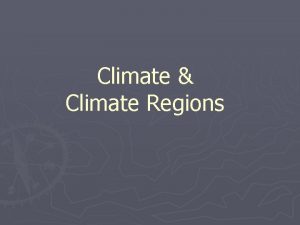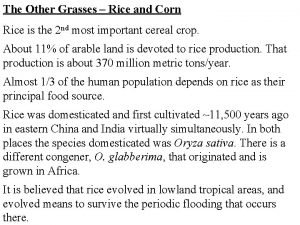Solving the Climate Challenge Prof Daniel Cohan Rice








































- Slides: 40

Solving the Climate Challenge Prof. Daniel Cohan, Rice University Houston Philosophical Society, February 15, 2018

Is climate change a problem?

Earth is Warming Overall Trend: 0. 17°C/decade 1. 1°C since 1880’s Earth has warmed about 2°F overall, and nearly 3°F over land Land-only Trend: 0. 29°C/decade 1. 7°C since 1880’s https: //www. ncdc. noaa. gov/cag/time-series/global 3

Warming is a problem

Warming may intensify hurricanes and floods • • Harvey-scale rain 6 x as likely (Emanuel, 2017) More severe but not more frequent hurricanes Precipitation increases ~7% per 1°C More extremes of rain and drought • Change in jet stream? – Our upcoming study

Ok, so there’s a problem. Who’s the culprit?

We (via greenhouse gases) are causing it Radiative forcing since 1750 IPCC 2013 Also, see Bloomberg: What’s really warming the world

What can we do to limit the damage? Risk = Hazard * Exposure * Vulnerability My focus tonight What we control via emissions Hazard Impacts What we control via adaptation and preparedness Article in The Conversation by Dessler, Cohan, and Hayhoe connecting this to Hurricane Harvey 8

How do we define the “climate challenge” to be solved? • Analogy to setting goals for diet and weight

How do we set goals for weight? Target Outcomes Actions and Offsets Targets by Component Target Measurement Target: Overall Consumption

How do we set goals for climate? Target Outcomes Actions and Offsets Target Measurement Targets: Emissions by Component Target: Emissions Overall

What goal to target? • Temperature goal – Pro: Tangible, can rally around it – Con: Uncertain how to reach it • Emissions goal – Pro: Can design control strategies – Con: Uncertain outcomes • PBS video: Why 2°C is the magic number

Goal of Paris Climate Agreement • “Global temperature rise this century well below 2°C above pre-industrial levels, and pursue efforts to limit the temperature increase even further to 1. 5°C”

Emissions pathways likely to achieve the Paris goal

1. 5 - 2°C means leaving most fossils in the ground 15

Paris Climate Pledges: Intended Nationally Determined Contributions

Paris 2020’s pledges are insufficient e r o ef is r a P B With Paris 2°C 1. 5°C 17

U. S. Paris emissions pledge: 26 -28% by 2025; 80% by 2050 base United States Mid-Century Strategy for Deep Decarbonization (White House, Nov. 2016)

Pathway to U. S. Paris pledge: 80% net emission reduction by 2050 United States Mid-Century Strategy for Deep Decarbonization (White House, Nov. 2016)

3 Steps to Decarbonize Energy Efficiency Decarboniz e Electricity Electrify as much as possible

How to decarbonize electricity: >30 GW/yr new wind + solar; nuclear; CCUS United States Mid-Century Strategy for Deep Decarbonization (White House, Nov. 2016)

Wind and solar cheaper than fossils, even before subsidies, externalities 22 Lazard, Levelized Cost of Energy, 2017

UBS expects EVs to reach total cost of ownership parity in 2020’s 23

Bloomberg New Energy Finance

Land sink opportunities U. S. Mid-century Deep Decarbonization Strategy

Jim Blackburn, Texas Coastal Exchange concept 26

Bio-Energy Carbon Capture and Storage National Academies, 2015

What policies do we need to drive these changes? United States Mid-Century Strategy for Deep Decarbonization (White House, Nov. 2016)

Waxman-Markey not enacted, but its caps are being met Emissions (Million Metric Tons CO 2, equiv) • Obama & Mc. Cain campaigned for cap-and-trade, 2008 • Waxman-Markey passed House in 2009; no vote in Senate Actual emissions lower than Waxman-Markey cap 29

Clean Power Plan not implemented, but being achieved Actual, ~1800 in 2017 EIA 2016 EPA projected impact of Clean Power Plan 30

Fuel economy standards tightening, but Trump may seek to weaken 31

Federal tax credits for wind and solar are phasing down 32

State and city pledges 33

State-level Renewable Portfolio Standards www. dsireusa. org / February 2017 ME: 40% x 2017 WA: 15% x 2020* ND: 10% x 2015 MT: 15% x 2015 OR: 50%x 2040* NH: 24. 8 x 2025 MN: 26. 5% x 2025 (IOUs) MA: 15% x 2020(new resources) 6. 03% x 2016 (existing resources) 31. 5% x 2020 (Xcel) (large utilities) SD: 10% x 2015 WI: 10% 2015 IA: 105 MW NV: 25% x 2025* CA: 50% x 2030 VT: 75% x 2032 UT: 20% x CO: 30% by 2020 2025*† (IOUs) *† KS: 20% x 2020 AZ: 15% x 2025* NM: 20%x 2020 (IOUs) NY: 50% x 2030 MI: 15% x 2021*† IN: OH: 12. 5% IL: 25% 10% x x 2026 2025† MO: 15% x 2021 RI: 38. 5% x 2035 CT: 27% x 2020 NJ: 20. 38% RE x 2020 + 4. 1% solar by 2027 PA: 18% x 2021† VA: 15% x 2025† DC NC: 12. 5% x 2021 (IOUs) OK: 15% x 2015 DE: 25% x 2026* MD: 25% x 2020 DC: 50% x 2032 SC: 2% 2021 TX: 5, 880 MW x 2015* 29 States + Washington U. S. Territories HI: 100% x 2045 Renewable portfolio standard Renewable portfolio goal *† NMI: 20% x 2016 Guam: 25% x 2035 PR: 20% x 2035 USVI: 30% x 2025 Extra credit for solar or customer-sited renewables Includes non-renewable alternative resources DC + 3 territories have a Renewable Portfolio Standard (8 states and 1 territories have renewable portfolio goals)

http: //portal. beyond-ratings. com/2016/04/carbon-pricing-world-map/ Carbon pricing policies 35

Corporate and voluntary efforts 36

Co-benefits of addressing climate change

Air quality improvements 38

Climate and health externalities of coal-fired generation in Texas 39

Conclusions • Global treaties have focused on T targets, but national efforts on emissions • U. S. emissions are declining, but: – Not driven by federal policies – Not fast enough for climate goals • Need efficiency, clean electricity, and to electrify as much as we can • Addressing climate helps our air & health 40
 Global carbon budget 2020
Global carbon budget 2020 Cohan sujay carlos
Cohan sujay carlos Climate change 2014 mitigation of climate change
Climate change 2014 mitigation of climate change Welcome to teen challenge uk - teen challenge uk
Welcome to teen challenge uk - teen challenge uk Hát kết hợp bộ gõ cơ thể
Hát kết hợp bộ gõ cơ thể Slidetodoc
Slidetodoc Bổ thể
Bổ thể Tỉ lệ cơ thể trẻ em
Tỉ lệ cơ thể trẻ em Gấu đi như thế nào
Gấu đi như thế nào Tư thế worms-breton
Tư thế worms-breton Hát lên người ơi alleluia
Hát lên người ơi alleluia Các môn thể thao bắt đầu bằng tiếng bóng
Các môn thể thao bắt đầu bằng tiếng bóng Thế nào là hệ số cao nhất
Thế nào là hệ số cao nhất Các châu lục và đại dương trên thế giới
Các châu lục và đại dương trên thế giới Công của trọng lực
Công của trọng lực Trời xanh đây là của chúng ta thể thơ
Trời xanh đây là của chúng ta thể thơ Mật thư anh em như thể tay chân
Mật thư anh em như thể tay chân Phép trừ bù
Phép trừ bù Phản ứng thế ankan
Phản ứng thế ankan Các châu lục và đại dương trên thế giới
Các châu lục và đại dương trên thế giới Thơ thất ngôn tứ tuyệt đường luật
Thơ thất ngôn tứ tuyệt đường luật Quá trình desamine hóa có thể tạo ra
Quá trình desamine hóa có thể tạo ra Một số thể thơ truyền thống
Một số thể thơ truyền thống Bàn tay mà dây bẩn
Bàn tay mà dây bẩn Vẽ hình chiếu vuông góc của vật thể sau
Vẽ hình chiếu vuông góc của vật thể sau Biện pháp chống mỏi cơ
Biện pháp chống mỏi cơ đặc điểm cơ thể của người tối cổ
đặc điểm cơ thể của người tối cổ Ví dụ về giọng cùng tên
Ví dụ về giọng cùng tên Vẽ hình chiếu đứng bằng cạnh của vật thể
Vẽ hình chiếu đứng bằng cạnh của vật thể Vẽ hình chiếu vuông góc của vật thể sau
Vẽ hình chiếu vuông góc của vật thể sau Thẻ vin
Thẻ vin đại từ thay thế
đại từ thay thế điện thế nghỉ
điện thế nghỉ Tư thế ngồi viết
Tư thế ngồi viết Diễn thế sinh thái là
Diễn thế sinh thái là Dạng đột biến một nhiễm là
Dạng đột biến một nhiễm là Các số nguyên tố là gì
Các số nguyên tố là gì Tư thế ngồi viết
Tư thế ngồi viết Lời thề hippocrates
Lời thề hippocrates Thiếu nhi thế giới liên hoan
Thiếu nhi thế giới liên hoan ưu thế lai là gì
ưu thế lai là gì
